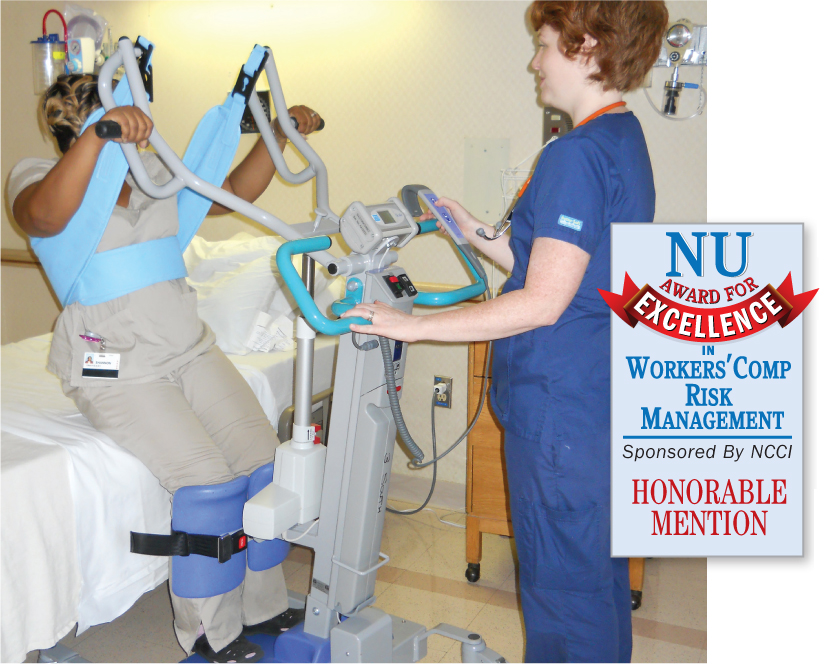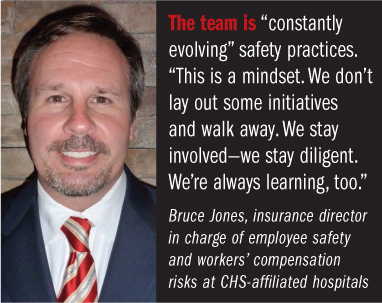Several years ago, Community Health Systems (CHS) ProfessionalService Corp. initiated a pilot program to improve employee safetyat a hospital in Watsonville, Calif. The loss history at thisfacility was, to put it bluntly, not good.
|“We knew if we could make our program work at this hospital, wewould learn enough to make it work in other hospitals,” says BruceJones, insurance director in charge of employee safety and workers'compensation risks at CHS-affiliated hospitals.
| As the project unfolded, Jonesand his team identified a risk that was costly in its impact andwhich they believed they could improve upon: musculoskeletalinjuries that were happening far too frequently—and usually as aresult of staffers hurting themselves when having to move extremelyobese patients.
As the project unfolded, Jonesand his team identified a risk that was costly in its impact andwhich they believed they could improve upon: musculoskeletalinjuries that were happening far too frequently—and usually as aresult of staffers hurting themselves when having to move extremelyobese patients.
“It was a trend we knew we could address and improve,” Jonessaid. “It's different than slip-and-fall claims. We can work toreduce those incidents, but they are still going to happen. But wesaw these back injuries coming in, and we knew we could come upwith a plan—and get the right equipment—to reduce the risk, costsand work time missed. This was where we could make the biggestdifference.”
|It took several years to perfect the Safe Patient Handling andTransfer Program (SPHTP) through the collection of data andassessment of the program's strong and weak points.
|Patient-lifting equipment was purchased, procedures and policieswere created and implemented, a training program was devised, andcompliance was tracked. The initial pilot program was expanded toinclude a larger group of hospitals, then a secondgroup.
|Altogether, the hospitals implementing the SPHTP reduced lossesby more than $11 million by the end of the third year.
|MERGER MULTIPLIES THE BENEFITS
|The timing of the SPHTP program could not have been better.After a merger with Triad Hospitals in 2007, CHS doubled in size.None of the newly acquired acute-care hospitals had loss-reductionand safety measures similar to the ones CHS had put inplace.
|“Hospitals are a complex work environment to begin with, and themerged facilities were not using our programs,” Jones says. “Eachlocation is different, so we had to customize what we were doing ina slightly different way for each hospital. But we had the programsin place and results to go to them and say, 'We want to help youmitigate losses, and this will lead to a better and more productiveworkforce.'”
|As CHS grew in number of facilities, its workers' compensationnumbers actually shrank. Total incidents decreased 6.5 percent from2008 to 2010, and the number of lost-time incidents was reduced by16.7 percent.
|The average cost per claim at CHS in 2010 was $1,017 compared to$1,602 at other healthcare clients of Gallagher Bassett, CHS'sthird-party administrator. CHS has reduced average lost work daysper claim by 57.7 percent since the policy term ending in 2006.
|MORALE BOOST
|According to feedback from hospitals, the SPHTP improved moraleamong nurses, reduced employee turnover, improved patient safety byreducing falls and has become a recruitment advantage as hospitalshire new nurses.
|All of this success is due not only to the SPHTP, but also toother workforce-safety initiatives that have been put inplace.
| Jones says he and his team are“constantly evolving” safety practices. They visit the facilitiesto assess how they are doing and what they need to do their jobseven better.
Jones says he and his team are“constantly evolving” safety practices. They visit the facilitiesto assess how they are doing and what they need to do their jobseven better.
“This is a mindset,” he says. “We don't lay out some initiativesand walk away. We stay involved—we stay diligent. We're alwayslearning, too.”
|A real difference in costs, for example, can be made by simplyemphasizing the importance of lag time in reporting an incident.CHS reduced the number of days from the date of loss to notice ofits TPA by 42 percent since 2008.
|“The faster we get into a claim, the lower the cost,” Jonessays.
Want to continue reading?
Become a Free PropertyCasualty360 Digital Reader
Your access to unlimited PropertyCasualty360 content isn’t changing.
Once you are an ALM digital member, you’ll receive:
- All PropertyCasualty360.com news coverage, best practices, and in-depth analysis.
- Educational webcasts, resources from industry leaders, and informative newsletters.
- Other award-winning websites including BenefitsPRO.com and ThinkAdvisor.com.
Already have an account? Sign In
© 2024 ALM Global, LLC, All Rights Reserved. Request academic re-use from www.copyright.com. All other uses, submit a request to [email protected]. For more information visit Asset & Logo Licensing.








